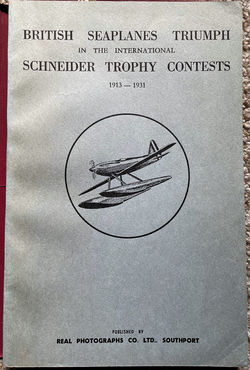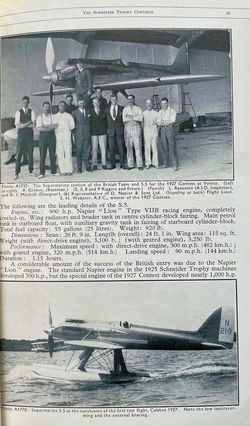BRITISH
SEAPLANES TRIUMPH – SCHNEIDER TROPHY RACES 1913-1931 SUPERMARINE GLOSTER
RARE, VINTAGE & AUTHENTIC SOFTBOUND
BOOK in ENGLISH by ELLISON HAWKS (1945)
-----------------------------
Additional Information from
Internet Encyclopedia
The Coupe d'Aviation Maritime
Jacques Schneider, also known as the Schneider Trophy, Schneider Prize or
Schneider Cup was a trophy awarded annually (and later, biennially) to the
winner of a race for seaplanes and flying boats. The Schneider Trophy is now
held at the Science Museum, South Kensington, London.
Announced in 1912 by Jacques
Schneider, a French financier, balloonist and aircraft enthusiast, the
competition offered a prize of approximately £1,000. The race was held twelve
times between 1913 and 1931. It was intended to encourage technical advances in
civil aviation but became a contest for pure speed with laps over a (usually)
triangular course, initially 280 km (170 mi) and later extended to 350 km (220
mi). The contests were staged as time trials, with aircraft setting off
individually at pre-agreed intervals, usually 15 minutes apart. The contests
were very popular and some attracted crowds of over 200,000 spectators.
The race was significant in
advancing aeroplane design, particularly in the fields of aerodynamics and
engine design, and would show its results in the best fighters of World War II.
The streamlined shape and the low drag, liquid-cooled engine pioneered by
Schneider Trophy designs are obvious in the British Supermarine Spitfire, the
American North American P-51 Mustang, and the Italian Macchi C.202 Folgore.
An earlier 1910 trophy for
landplanes, Grande Semaine d'Aviation de Tours also presented by Jacques
Schneider, in France, was also known as the Schneider Cup, this is now in the
possession of the RAF College Cranwell.
If an aero club won three races
in five years, they would retain the trophy and the winning pilot would receive
75,000 francs for each of the first three wins. Each race was hosted by the
previous winning country. The races were supervised by the Fédération
Aéronautique Internationale and the aero club in the hosting country. Each club
could enter up to three competitors with an equal number of alternatives.
Schneider Trophy
The Schneider Trophy is a
sculpture of silver & bronze set on a marble base. It depicts a zephyr
skimming the waves, and a nude winged figure is seen kissing a zephyr recumbent
on a breaking wave. The heads of two other zephyrs and of Neptune, the god of
the Sea, can be seen surrounded by octopus and crabs. The symbolism represents
speed conquering the elements of sea and air. The cost of the trophy was 25,000
francs.
The trophy itself has been
entrusted to the Royal Aero Club and can be viewed along with the winning
Supermarine S.6B floatplane at the London Science Museum Flight exhibition
hall. Supermarine S.6, N248, which competed in the 1929 contest but was
disqualified, is preserved at Solent Sky maritime museum in Southampton.
History
Schneider was a hydroplane racer
who came from a wealthy family; his interest in aircraft began after he met
Wilbur Wright in 1908, but a boating accident in 1910 crippled him and
prematurely ended his racing and flying career. Schneider served as a race
referee at the Monaco Hydroplane Meet in 1912, where he noted that seaplane development
was lagging land-based aircraft; seeking to spur amphibious aircraft
development, capable of reliable operation, extended range, and reasonable
payload capacity, he announced the annual Schneider Trophy competition at a
race banquet on December 5, to cover a distance of at least 150 nautical miles
(280 km; 170 mi).
The first competition was held
on 16 April 1913, at Monaco, consisting of six laps, 300 kilometres (190 mi)
distance in total. It was won by Maurice Prévost, piloting a French Deperdussin
Monocoque (Coupe Schneider) at an average speed of 73.56 km/h (45.71 mph).
Although Prévost had averaged a faster flying speed, he lost 50 minutes when he
landed prematurely after losing count of the laps completed. All four entrants
were flying French-made aircraft; two withdrew before completing the race. The
British won in 1914 with a Sopwith Tabloid flown by Howard Pixton at 139.74
km/h (86.83 mph); the 1914 race was contested by three nations: France, the
United Kingdom, and Switzerland. The United States and Germany failed to
qualify. From 1915 to 1918, competition was suspended for the duration of World
War I.
After the war, the competition
resumed in 1919 at Bournemouth where in foggy conditions the Italian team won.
They were later disqualified and the race was voided, as the referees ruled
they had incorrectly flown around a marker buoy. In 1920 and 1921 at Venice the
Italians won again; in 1920 no other nation entered and in 1921 the French
entry did not start. Had it not been for the 1919 disqualification, Italy would
have been awarded the trophy permanently. After 1921, an additional requirement
was added: the winning seaplane had to remain moored to a buoy for six hours
without human intervention.
In 1922 in Naples the British
and French competed with the Italians. The British private entry, a Supermarine
Sea Lion II, was the victor, flown by Henry Biard. The French aircraft did not
start the race, which became a competition between the Sea Lion and three
Italian aircraft, two Macchi M.17s and a Savoia S.51.
Nationalism
The 1923 trophy, contested at
Cowes, went to the Americans with a sleek, liquid-cooled engined craft designed
by Glenn Curtiss. It used the Curtiss D-12 engine. US Navy Lieutenant David
Rittenhouse won the cup, and his teammate Rutledge Irvine was second in an
identical aircraft. The British Sea Lion III (flown by 1922 winner Henry
Biard), and the French entry withdrew from the race. The preparation of the
United States team, backed by government support and using Curtiss racing biplanes
derived from inter-military competitions, increased the speed and the
investment of a winning entry significantly. In 1924 the competition was
cancelled as no other nation turned out to face the Americans: the Italians and
the French withdrew; and both British craft crashed in pre-race trials. In 1925
at Chesapeake Bay the Americans won again, with US pilot Jimmy Doolittle
winning in a Curtiss R3C ahead of the British Gloster III and the Italian
Macchi M.33. Two British planes did not compete (R. J. Mitchell's Supermarine
S.4 and the other Gloster III were damaged before the race). Two of the
American planes did not finish.
Benito Mussolini instructed the
Italian aircraft industry to "win the Schneider Trophy at all costs"
and so demonstrate the effectiveness of his Fascist government. In 1926, the
Italians returned with a Macchi M.39 and won against the Americans with a
396.69 km/h (246.49 mph) run at Hampton Roads. The United States, short of
funds, did not develop new aircraft for the 1926 title defence; the M.39,
designed by Mario Castoldi, used a Fiat AS2 engine and was streamlined in the
manner of the 1925 Supermarine and Curtiss entrants. The American teams
withdrew from further competition after the 1926 race, as the military were
unwilling to fund entrants. In 1927 at Venice the British responded by
enlisting government backing and RAF pilots (the High Speed Flight) for the
Supermarine, Gloster, and Shorts entries. Supermarine's Mitchell-designed S.5s
took first and second places; no other entrants finished. The race was
witnessed by an estimated 250,000 spectators.[16] 1927 was the last annual
competition, the event then moving to a biennial schedule to allow for more
development time under mutual agreement.
In 1929, at Calshot, Supermarine
won again in the Supermarine S.6 with the new Rolls-Royce R engine with an
average speed of 528.89 km/h (328.64 mph). Both Britain and Italy entered two
new aircraft and a backup plane from the previous race. Three of the four new
aircraft were disqualified (Supermarine S.6 N.248) or failed to finish the
course (both Macchi M.67s), with the older Macchi M.52R taking second and
Supermarine S.5 taking third. Although France had ordered racing seaplanes from
Bernard and Nieuport-Delage in 1928, they were unable to complete them in time
for the 1929 race.
In 1931 the British government
withdrew support, but a private donation of £100,000 from the wealthy and
ultra-patriotic Lucy, Lady Houston, allowed Supermarine to compete. When the
French and Italian teams dropped out, leaving no other competitors, the British
team flew the course alone on 13 September and won the coveted Schneider Trophy
outright, having beaten the time record from the 1929 competition. Reportedly
half a million spectators lined the beachfronts. The Italian, French, and
German entrants failed to ready their aircraft in time for the competition. The
remaining British team set both a new world speed record of 610 km/h (380 mph)
and won the trophy outright with a third straight win. The following days saw
the winning Supermarine S.6B further break the world speed record twice, making
it the first craft to break the 400 mph barrier on 29 September at an average
speed of 655.8 km/h (407.5 mph).
Although the British team had
secured the trophy for the UK permanently with the 1931 uncontested win,
development of the other 1931 entrants continued. The proposed Italian entrant
(the Macchi M.C.72) which had pulled out of the contest due to engine problems
later went on to set two new world speed records. In April 1933 (over Lake
Garda, in northern Italy) it set a record with a speed of 682.36 km/h (424.00
mph). Eighteen months later in the same venue, it broke the 700 km/h barrier
with an average speed of 709.202 km/h (440.678 mph). Both times the plane was
piloted by Francesco Agello. This speed remains the fastest speed ever attained
by a piston-engined seaplane.






